HUMMER H3 2009 Owners Manual
Manufacturer: HUMMER, Model Year: 2009, Model line: H3, Model: HUMMER H3 2009Pages: 382, PDF Size: 1.99 MB
Page 221 of 382
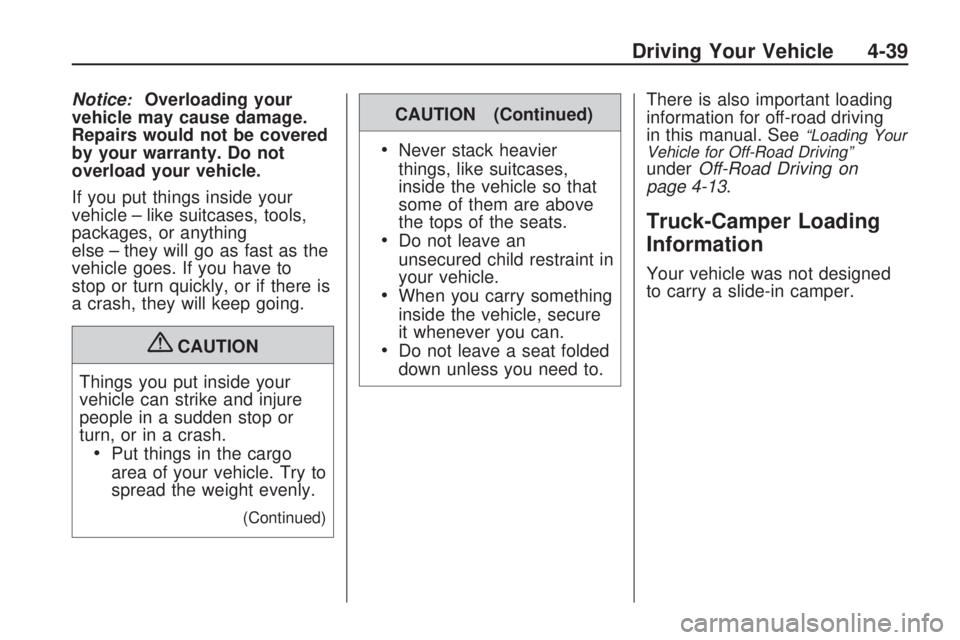
Notice:Overloading your
vehicle may cause damage.
Repairs would not be covered
by your warranty. Do not
overload your vehicle.
If you put things inside your
vehicle – like suitcases, tools,
packages, or anything
else – they will go as fast as the
vehicle goes. If you have to
stop or turn quickly, or if there is
a crash, they will keep going.
{CAUTION
Things you put inside your
vehicle can strike and injure
people in a sudden stop or
turn, or in a crash.
Put things in the cargo
area of your vehicle. Try to
spread the weight evenly.
(Continued)
CAUTION (Continued)
Never stack heavier
things, like suitcases,
inside the vehicle so that
some of them are above
the tops of the seats.
Do not leave an
unsecured child restraint in
your vehicle.
When you carry something
inside the vehicle, secure
it whenever you can.
Do not leave a seat folded
down unless you need to.There is also important loading
information for off-road driving
in this manual. See
“Loading Your
Vehicle for Off-Road Driving”
underOff-Road Driving on
page 4-13.
Truck-Camper Loading
Information
Your vehicle was not designed
to carry a slide-in camper.
Driving Your Vehicle 4-39
Page 222 of 382
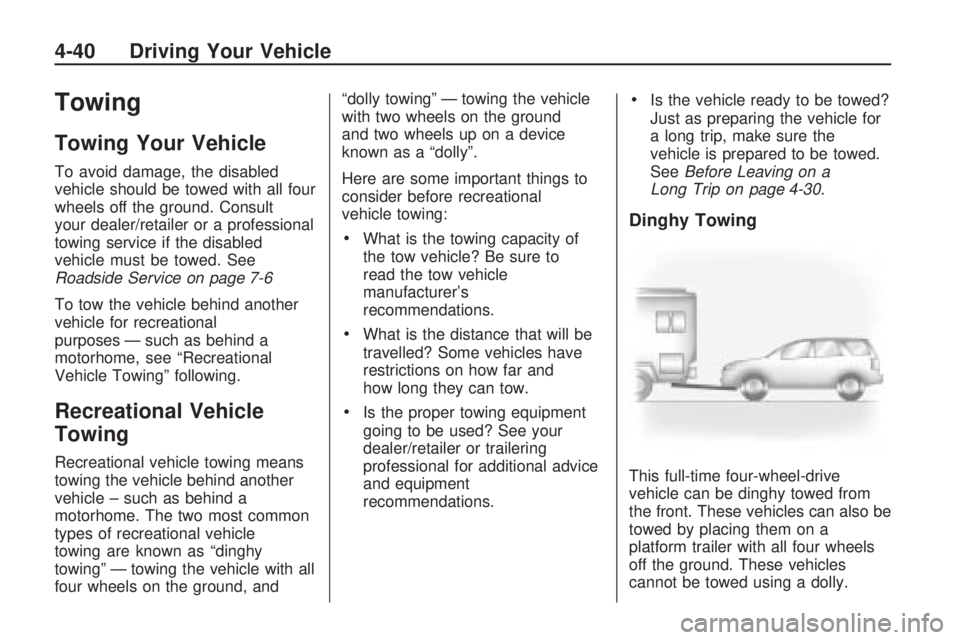
Towing
Towing Your Vehicle
To avoid damage, the disabled
vehicle should be towed with all four
wheels off the ground. Consult
your dealer/retailer or a professional
towing service if the disabled
vehicle must be towed. See
Roadside Service on page 7-6
To tow the vehicle behind another
vehicle for recreational
purposes — such as behind a
motorhome, see “Recreational
Vehicle Towing” following.
Recreational Vehicle
Towing
Recreational vehicle towing means
towing the vehicle behind another
vehicle – such as behind a
motorhome. The two most common
types of recreational vehicle
towing are known as “dinghy
towing” — towing the vehicle with all
four wheels on the ground, and“dolly towing” — towing the vehicle
with two wheels on the ground
and two wheels up on a device
known as a “dolly”.
Here are some important things to
consider before recreational
vehicle towing:
What is the towing capacity of
the tow vehicle? Be sure to
read the tow vehicle
manufacturer’s
recommendations.
What is the distance that will be
travelled? Some vehicles have
restrictions on how far and
how long they can tow.
Is the proper towing equipment
going to be used? See your
dealer/retailer or trailering
professional for additional advice
and equipment
recommendations.
Is the vehicle ready to be towed?
Just as preparing the vehicle for
a long trip, make sure the
vehicle is prepared to be towed.
SeeBefore Leaving on a
Long Trip on page 4-30.
Dinghy Towing
This full-time four-wheel-drive
vehicle can be dinghy towed from
the front. These vehicles can also be
towed by placing them on a
platform trailer with all four wheels
off the ground. These vehicles
cannot be towed using a dolly.
4-40 Driving Your Vehicle
Page 223 of 382

Use the following procedure to tow
the vehicle:
1. Put the transmission in P (Park)
for an automatic transmission or
in 1 (First) for a manual
transmission.
2. Turn the engine off, but leave the
ignition in ACC/ACCESSORY.
3. Firmly set the parking brake.
4. Securely attach the vehicle being
towed to the tow vehicle.
{CAUTION
Shifting a full-time
four-wheel-drive vehicle’s
transfer case into N (Neutral)
can cause the vehicle to roll
even if the automatic transmission
is in P (Park) or the manual
transmission is in any gear. You
or others could be injured. Make
sure the parking brake is �rmly
set before the transfer case is
shifted to N (Neutral).5. Shift the transfer case to
N (Neutral). SeeFull-Time
Four-Wheel Drive on page 2-24
for the proper procedure to
select the N (Neutral) position for
the vehicle.
6. Release the parking brake only
after the vehicle being towed is
�rmly attached to the tow vehicle.
7. Make sure the ignition is in
ACC/ACCESSORY.
When towing the vehicle for
extended periods of time, start the
vehicle as often as possible to
prevent battery drain. This should
only be done when the tow
vehicle is parked.
After towing, see “Shifting Out of
NEUTRAL” underFull-Time
Four-Wheel Drive on page 2-24.
Dolly Towing
Notice:Dolly towing the vehicle
will damage drivetrain
components. Do not dolly tow the
vehicle.
The vehicle cannot be dolly towed.
If the vehicle must be towed
behind another vehicle, use the
dinghy towing procedure explained
previously.
Driving Your Vehicle 4-41
Page 224 of 382
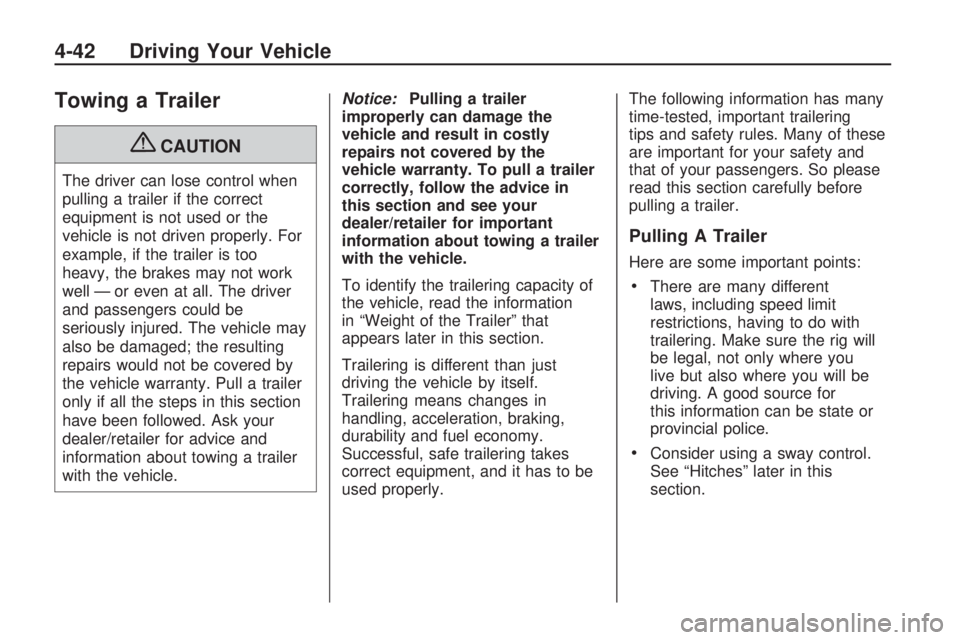
Towing a Trailer
{CAUTION
The driver can lose control when
pulling a trailer if the correct
equipment is not used or the
vehicle is not driven properly. For
example, if the trailer is too
heavy, the brakes may not work
well — or even at all. The driver
and passengers could be
seriously injured. The vehicle may
also be damaged; the resulting
repairs would not be covered by
the vehicle warranty. Pull a trailer
only if all the steps in this section
have been followed. Ask your
dealer/retailer for advice and
information about towing a trailer
with the vehicle.Notice:Pulling a trailer
improperly can damage the
vehicle and result in costly
repairs not covered by the
vehicle warranty. To pull a trailer
correctly, follow the advice in
this section and see your
dealer/retailer for important
information about towing a trailer
with the vehicle.
To identify the trailering capacity of
the vehicle, read the information
in “Weight of the Trailer” that
appears later in this section.
Trailering is different than just
driving the vehicle by itself.
Trailering means changes in
handling, acceleration, braking,
durability and fuel economy.
Successful, safe trailering takes
correct equipment, and it has to be
used properly.The following information has many
time-tested, important trailering
tips and safety rules. Many of these
are important for your safety and
that of your passengers. So please
read this section carefully before
pulling a trailer.
Pulling A Trailer
Here are some important points:
There are many different
laws, including speed limit
restrictions, having to do with
trailering. Make sure the rig will
be legal, not only where you
live but also where you will be
driving. A good source for
this information can be state or
provincial police.
Consider using a sway control.
See “Hitches” later in this
section.
4-42 Driving Your Vehicle
Page 225 of 382

Do not tow a trailer at all during
the �rst 500 miles (800 km) the
new vehicle is driven. The
engine, axle or other parts could
be damaged.
Then, during the �rst 500 miles
(800 km) that a trailer is towed,
do not drive over 50 mph
(80 km/h) and do not make starts
at full throttle. This helps the
engine and other parts of
the vehicle wear in at the
heavier loads.
Vehicles with an automatic
transmissions can tow in
D (Drive). Shift the transmission
to a lower gear if the
transmission shifts too often
under heavy loads and/or hilly
conditions. For vehicles with
a manual transmission, it is better
not to use the highest gear.
This vehicle has a Hill Start
Assist feature, which may
be useful when the vehicle is
stopped on a grade. SeeBraking
on page 4-3for more information.
Three important considerations have
to do with weight:
The weight of the trailer
The weight of the trailer tongue
The weight on the vehicle’s tires
Weight of the Trailer
How heavy can a trailer safely be?
It depends on how the rig is
used. For example, speed, altitude,
road grades, outside temperature
and how much the vehicle is used to
pull a trailer are all important. It
can depend on any special
equipment on the vehicle, and the
amount of tongue weight the vehicle
can carry. See “Weight of the
Trailer Tongue” later in this section
for more information.
Driving Your Vehicle 4-43
Page 226 of 382
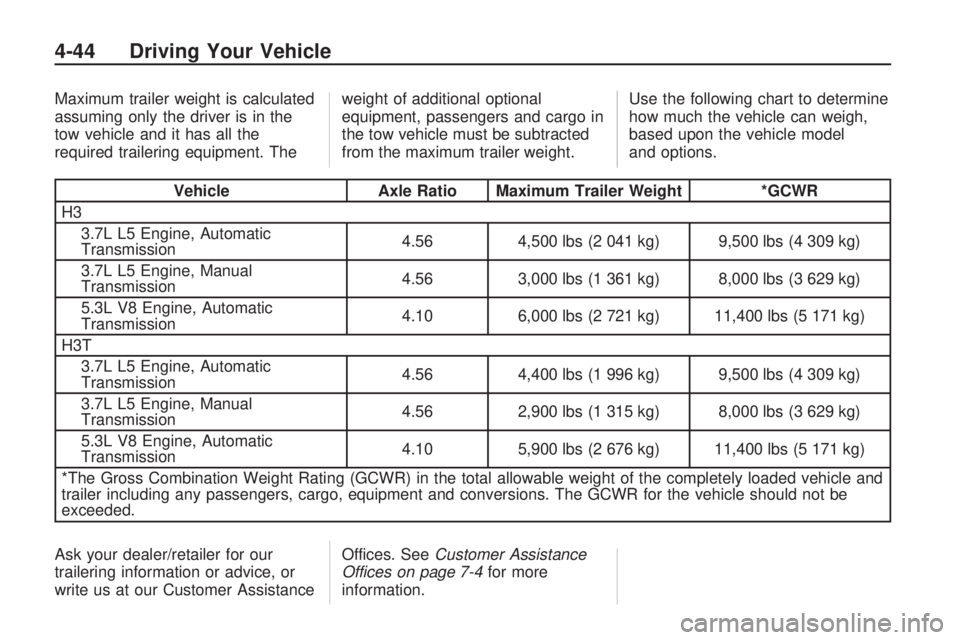
Maximum trailer weight is calculated
assuming only the driver is in the
tow vehicle and it has all the
required trailering equipment. Theweight of additional optional
equipment, passengers and cargo in
the tow vehicle must be subtracted
from the maximum trailer weight.Use the following chart to determine
how much the vehicle can weigh,
based upon the vehicle model
and options.
Vehicle
Axle Ratio Maximum Trailer Weight *GCWR
H3 3.7L L5 Engine, Automatic
Transmission 4.56
4,500 lbs (2 041 kg) 9,500 lbs (4 309 kg)
3.7L L5 Engine, Manual
Transmission 4.56
3,000 lbs (1 361 kg) 8,000 lbs (3 629 kg)
5.3L V8 Engine, Automatic
Transmission 4.10
6,000 lbs (2 721 kg) 11,400 lbs (5 171 kg)
H3T 3.7L L5 Engine, Automatic
Transmission 4.56
4,400 lbs (1 996 kg) 9,500 lbs (4 309 kg)
3.7L L5 Engine, Manual
Transmission 4.56
2,900 lbs (1 315 kg) 8,000 lbs (3 629 kg)
5.3L V8 Engine, Automatic
Transmission 4.10
5,900 lbs (2 676 kg) 11,400 lbs (5 171 kg)
*The Gross Combination Weight Rating (GCWR) in the total allowable weight of the completely loaded vehicle and
trailer including any passengers, cargo, equipment and conversions. The GCWR for the vehicle should not be
exceeded.
Ask your dealer/retailer for our
trailering information or advice, or
write us at our Customer Assistance Offices. See
Customer Assistance
Offices on page 7-4 for more
information.
4-44 Driving Your Vehicle
Page 227 of 382
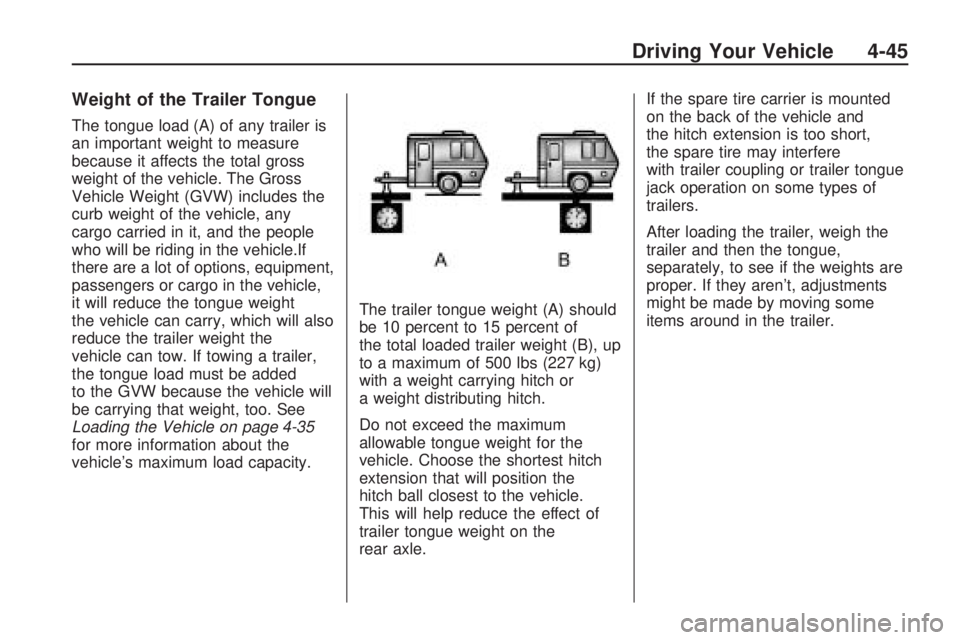
Weight of the Trailer Tongue
The tongue load (A) of any trailer is
an important weight to measure
because it affects the total gross
weight of the vehicle. The Gross
Vehicle Weight (GVW) includes the
curb weight of the vehicle, any
cargo carried in it, and the people
who will be riding in the vehicle.If
there are a lot of options, equipment,
passengers or cargo in the vehicle,
it will reduce the tongue weight
the vehicle can carry, which will also
reduce the trailer weight the
vehicle can tow. If towing a trailer,
the tongue load must be added
to the GVW because the vehicle will
be carrying that weight, too. See
Loading the Vehicle on page 4-35
for more information about the
vehicle’s maximum load capacity.The trailer tongue weight (A) should
be 10 percent to 15 percent of
the total loaded trailer weight (B), up
to a maximum of 500 lbs (227 kg)
with a weight carrying hitch or
a weight distributing hitch.
Do not exceed the maximum
allowable tongue weight for the
vehicle. Choose the shortest hitch
extension that will position the
hitch ball closest to the vehicle.
This will help reduce the effect of
trailer tongue weight on the
rear axle.If the spare tire carrier is mounted
on the back of the vehicle and
the hitch extension is too short,
the spare tire may interfere
with trailer coupling or trailer tongue
jack operation on some types of
trailers.
After loading the trailer, weigh the
trailer and then the tongue,
separately, to see if the weights are
proper. If they aren’t, adjustments
might be made by moving some
items around in the trailer.
Driving Your Vehicle 4-45
Page 228 of 382
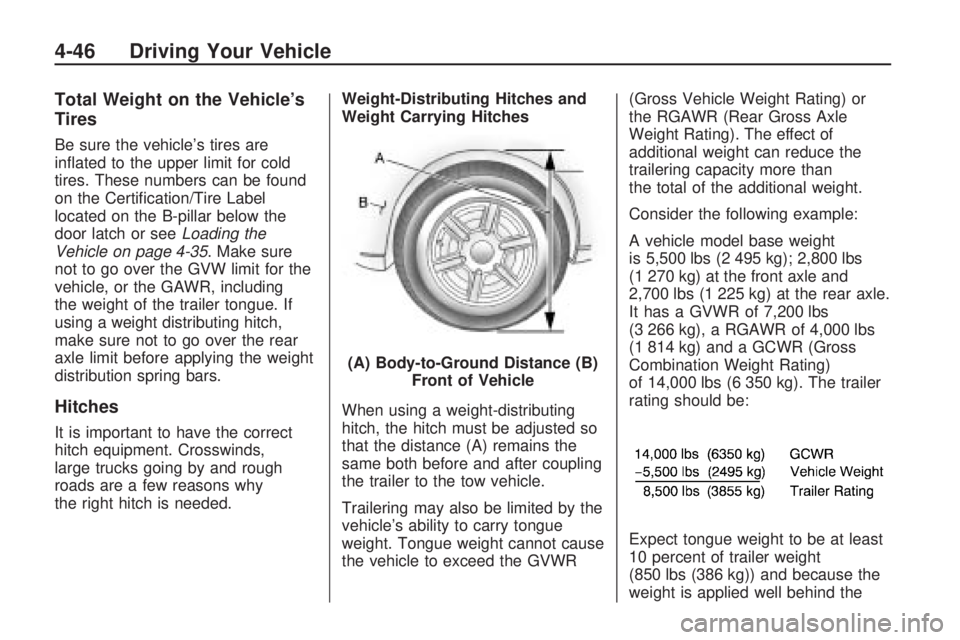
Total Weight on the Vehicle’s
Tires
Be sure the vehicle’s tires are
in�ated to the upper limit for cold
tires. These numbers can be found
on the Certi�cation/Tire Label
located on the B-pillar below the
door latch or seeLoading the
Vehicle on page 4-35. Make sure
not to go over the GVW limit for the
vehicle, or the GAWR, including
the weight of the trailer tongue. If
using a weight distributing hitch,
make sure not to go over the rear
axle limit before applying the weight
distribution spring bars.
Hitches
It is important to have the correct
hitch equipment. Crosswinds,
large trucks going by and rough
roads are a few reasons why
the right hitch is needed.Weight-Distributing Hitches and
Weight Carrying Hitches
When using a weight-distributing
hitch, the hitch must be adjusted so
that the distance (A) remains the
same both before and after coupling
the trailer to the tow vehicle.
Trailering may also be limited by the
vehicle’s ability to carry tongue
weight. Tongue weight cannot cause
the vehicle to exceed the GVWR(Gross Vehicle Weight Rating) or
the RGAWR (Rear Gross Axle
Weight Rating). The effect of
additional weight can reduce the
trailering capacity more than
the total of the additional weight.
Consider the following example:
A vehicle model base weight
is 5,500 lbs (2 495 kg); 2,800 lbs
(1 270 kg) at the front axle and
2,700 lbs (1 225 kg) at the rear axle.
It has a GVWR of 7,200 lbs
(3 266 kg), a RGAWR of 4,000 lbs
(1 814 kg) and a GCWR (Gross
Combination Weight Rating)
of 14,000 lbs (6 350 kg). The trailer
rating should be:
Expect tongue weight to be at least
10 percent of trailer weight
(850 lbs (386 kg)) and because the
weight is applied well behind the (A) Body-to-Ground Distance (B)
Front of Vehicle
4-46 Driving Your Vehicle
Page 229 of 382
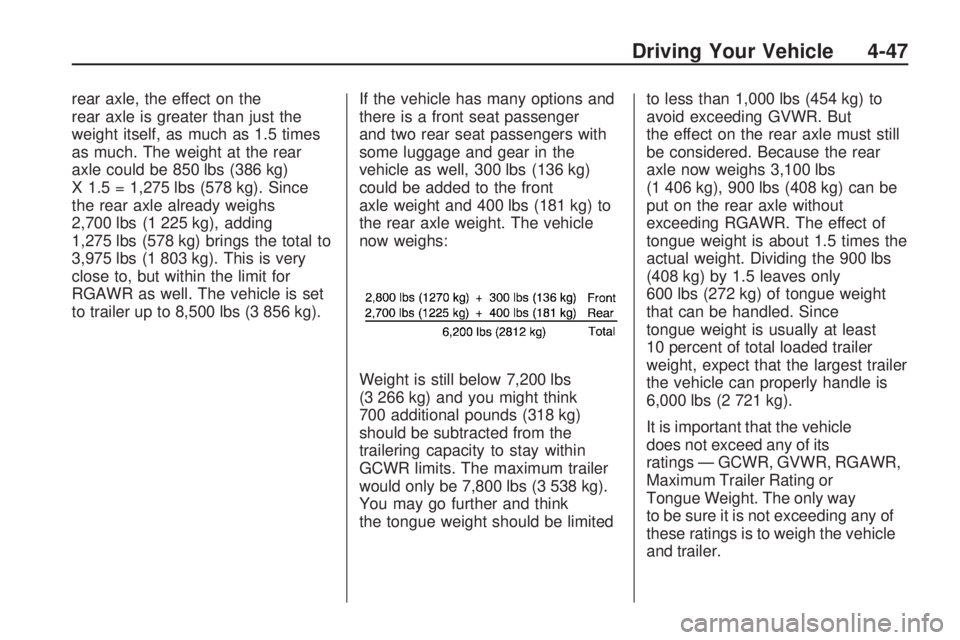
rear axle, the effect on the
rear axle is greater than just the
weight itself, as much as 1.5 times
as much. The weight at the rear
axle could be 850 lbs (386 kg)
X 1.5 = 1,275 lbs (578 kg). Since
the rear axle already weighs
2,700 lbs (1 225 kg), adding
1,275 lbs (578 kg) brings the total to
3,975 lbs (1 803 kg). This is very
close to, but within the limit for
RGAWR as well. The vehicle is set
to trailer up to 8,500 lbs (3 856 kg).If the vehicle has many options and
there is a front seat passenger
and two rear seat passengers with
some luggage and gear in the
vehicle as well, 300 lbs (136 kg)
could be added to the front
axle weight and 400 lbs (181 kg) to
the rear axle weight. The vehicle
now weighs:
Weight is still below 7,200 lbs
(3 266 kg) and you might think
700 additional pounds (318 kg)
should be subtracted from the
trailering capacity to stay within
GCWR limits. The maximum trailer
would only be 7,800 lbs (3 538 kg).
You may go further and think
the tongue weight should be limitedto less than 1,000 lbs (454 kg) to
avoid exceeding GVWR. But
the effect on the rear axle must still
be considered. Because the rear
axle now weighs 3,100 lbs
(1 406 kg), 900 lbs (408 kg) can be
put on the rear axle without
exceeding RGAWR. The effect of
tongue weight is about 1.5 times the
actual weight. Dividing the 900 lbs
(408 kg) by 1.5 leaves only
600 lbs (272 kg) of tongue weight
that can be handled. Since
tongue weight is usually at least
10 percent of total loaded trailer
weight, expect that the largest trailer
the vehicle can properly handle is
6,000 lbs (2 721 kg).
It is important that the vehicle
does not exceed any of its
ratings — GCWR, GVWR, RGAWR,
Maximum Trailer Rating or
Tongue Weight. The only way
to be sure it is not exceeding any of
these ratings is to weigh the vehicle
and trailer.
Driving Your Vehicle 4-47
Page 230 of 382
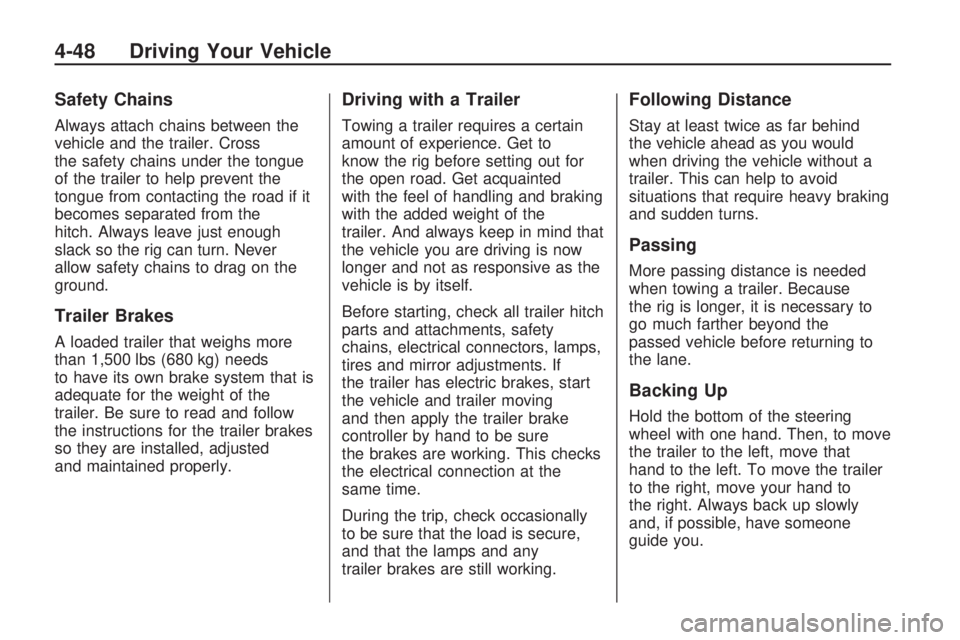
Safety Chains
Always attach chains between the
vehicle and the trailer. Cross
the safety chains under the tongue
of the trailer to help prevent the
tongue from contacting the road if it
becomes separated from the
hitch. Always leave just enough
slack so the rig can turn. Never
allow safety chains to drag on the
ground.
Trailer Brakes
A loaded trailer that weighs more
than 1,500 lbs (680 kg) needs
to have its own brake system that is
adequate for the weight of the
trailer. Be sure to read and follow
the instructions for the trailer brakes
so they are installed, adjusted
and maintained properly.
Driving with a Trailer
Towing a trailer requires a certain
amount of experience. Get to
know the rig before setting out for
the open road. Get acquainted
with the feel of handling and braking
with the added weight of the
trailer. And always keep in mind that
the vehicle you are driving is now
longer and not as responsive as the
vehicle is by itself.
Before starting, check all trailer hitch
parts and attachments, safety
chains, electrical connectors, lamps,
tires and mirror adjustments. If
the trailer has electric brakes, start
the vehicle and trailer moving
and then apply the trailer brake
controller by hand to be sure
the brakes are working. This checks
the electrical connection at the
same time.
During the trip, check occasionally
to be sure that the load is secure,
and that the lamps and any
trailer brakes are still working.
Following Distance
Stay at least twice as far behind
the vehicle ahead as you would
when driving the vehicle without a
trailer. This can help to avoid
situations that require heavy braking
and sudden turns.
Passing
More passing distance is needed
when towing a trailer. Because
the rig is longer, it is necessary to
go much farther beyond the
passed vehicle before returning to
the lane.
Backing Up
Hold the bottom of the steering
wheel with one hand. Then, to move
the trailer to the left, move that
hand to the left. To move the trailer
to the right, move your hand to
the right. Always back up slowly
and, if possible, have someone
guide you.
4-48 Driving Your Vehicle